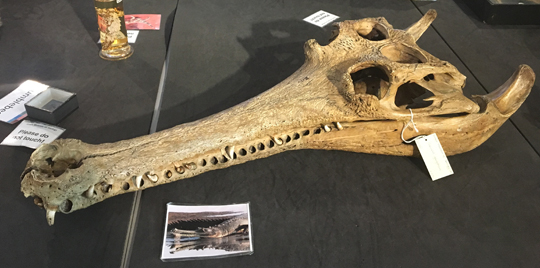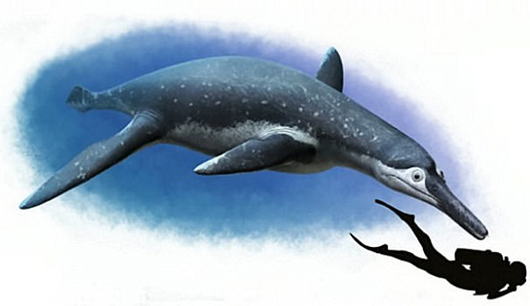Luskhan itilensis – Giant Pliosaurid from Russia
A team of international researchers have announced the discovery of a new species of giant marine reptile, a pliosaur that has been named Luskhan itilensis. Writing in the academic journal “Current Biology”, the scientists state that the fossils, which represent a single animal, indicate that this Early Cretaceous reptile was huge. The skull is estimated at 1.5 metres long, suggesting that L. itilensis might have reached lengths in excess of ten metres.
The New Giant Marine Reptile (Luskhan itilensis) Compared to a Frogman
Picture credit: Andrey Atuchin
Three-dimensional Fossil Skeleton (Luskhan itilensis)
The fossil material was excavated from a bank on the river Volga, close to the town of Ulyanovsk, in the Volga Federal District of Russia. It is estimated to be around 130 million years old (Early Cretaceous). Members of the family known as the Pliosauridae typically have very large skulls, strong, powerful jaws with big teeth. These marine reptiles, distantly related to the plesiosaurs, “fly” through the water propelled by their large flippers. Most of these animals are regarded as fearsome, apex predators. Pliosaurs such as Kronosaurus, Pliosaurus and Liopleurodon represent the top predators within their ecosystems.
A Model of the Apex Predator Kronosaurus (K. queenslandicus)
The model (above) is a PNSO Kronosaurus.
To view the range of PNSO prehistoric animal figures in stock: PNSO Age of Dinosaurs.
A Specialised Fish-eater
Examination of the snout of this new pliosaurid, the rostrum, suggested to the scientists that this marine reptile may have filled a different niche in ancient marine ecosystems compared to other Pliosaurs. The long jaws reminded the researchers of the snouts of gavials (gharials), a type of crocodile that is a specialist fish-eater.
A Photograph of a Gharial Skull (Gavial)

The skull of a gharial from the Grant Museum of Zoology (London). Picture credit: Everything Dinosaur.
Picture credit: Everything Dinosaur
The research team postulate that Luskhan itilensis was not an apex predator but a specialist fish-eater (piscivore). This suggests that over the long history of this marine reptile group, the pliosaurs evolved into different forms and occupied a variety of niches in Mesozoic marine ecosystems.
Teaching Extensions
Linking to adaptation and inheritance, ask students to look at pictures of various crocodilians, paying particular attention to the skull and jaws. What similarities can the students identify? What differences can the students detect? A clue – look at jaw shape and teeth. How does the shape of the jaws and the size of the teeth relate to diet?
For educational themed prehistoric animal toys and games: Educational Prehistoric Animal Toys and Games.



